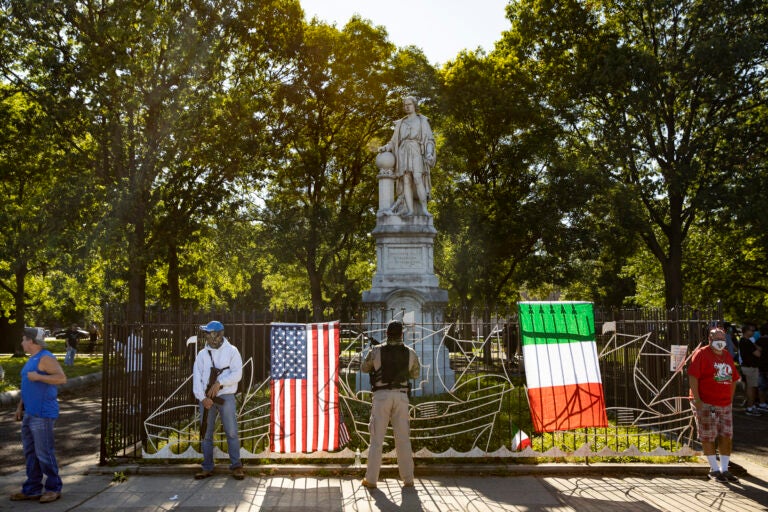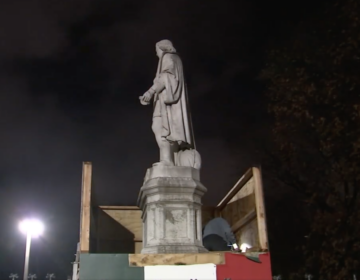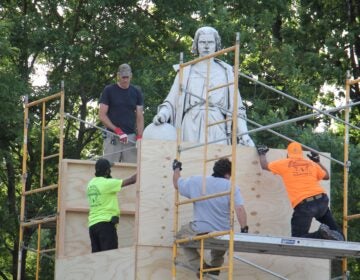‘What’s next?’ Rage greets city plan to remove Marconi Plaza’s Christopher Columbus statue
Cultural divides took center stage at the first public hearing on Mayor Jim Kenney’s plan to uproot Marconi Plaza’s Christopher Columbus statue.

A group of armed people guard a statue of Christopher Columbus located in Marconi Park on South Broad St. These men said they believed that Black Lives Matter/ANTIFA protestors were on their way to destroy the statue. (Courtesy of Ryan Collerd)
Sharp cultural divides over racism, history and police violence took center stage at the first public hearing on Mayor Jim Kenney’s proposal to remove a statue of Christopher Columbus from a South Philadelphia park.
For more than five hours, a diverse cast of Philadelphians debated over Zoom the city’s case for removing the statue — a conversation that began with the city’s Public Art Director Margot Berg’s argument for the move. Berg cited recent incidents of violence beginning on June 13, when a group of people, some armed with rifles, baseball bats and other weapons, surrounded the Marconi Plaza statue. The individuals, many of them white men who described themselves as neighborhood residents, said they were there to protect the icon after heated Black Lives Matter protests at a subsequently removed statue of former mayor Frank Rizzo and elsewhere in the city.
“From a public safety and risk standpoint, it is not feasible nor is it in the public interest for the Columbus statue to remain on display in Marconi Plaza,” Berg concluded during the Philadelphia Art Commission hearing. She noted that on June 16, the statue was boarded up in an attempt to deter future conflict and is currently under constant surveillance by a police cruiser.
The Kenney administration’s stance is supported by a survey conducted that sought to gather public input about the statue and what neighborhood residents feel it symbolizes, Berg said. The survey was promoted through social media, and as of June 15, had generated 12,877 responses.
According to preliminary analysis, the survey found that 80% of respondents have negative associations with the statue, associated with responses that included words like “false history, racism, etc.,” Berg said. Only 20% felt that it had positive ones, associated with words like “Italian American pride, American history.”
Despite concerns raised regarding the validity of the survey and the promotion of the special meeting, with many commenters suggesting that older members of the South Philadelphia community might lack access to social media and the internet, the hours of public testimony encompassed a variety of perspectives.
On multiple occasions, the statue was likened to both a statue of Hitler and to a Holocaust memorial. “What’s next?” asked retired Pennsylvania Supreme Court Justice Seamus McCafferty. “How about the Holocaust monuments, are they going to be removed? How about William Penn? Will that be removed? How about our U.S. currency? Will that be changed? We have to put an end to this nonsense.”
While some view the statue as a symbol of of Italian American history and culture that celebrates the legacy of Italian immigration, others see it as a symbol of white supremacy, genocide, and colonialism. This debate reflects many of the tensions and complexities underlying public commemoration and cultural symbolism playing out across the country.
The first half of the hearing seemed to be dominated by those in favor of keeping the statue, many of whom also appear in a lineup put together by George Bochetto, who represents Friends of Marconi Plaza, to testify before the Philadelphia Historical Commission in a second public hearing on Friday. Included in that list is Former Senator Vincent Fumo, who described the situation as “Kafkaesque.”
“I watched the mayor make his racist comments towards this monument, which is representative of Italian Americans,” Fumo said. “The mayor worked for me for 20 years plus, he was never taught to be this offensive,” he continued, “somewhere along the line, he caught this disease.”
The former senator, who was convicted of multiple federal corruption charges, said that calls to remove the statue are coming now, after “a bunch of middle-class, probably unemployed because of the pandemic, student-type children” decided to take issue with it.
Fumo made similar comments after Kenney removed the Rizzo statue, another icon built with the support of the city’s Italian American community. After days of militarized confrontation between armed police and protestors, city workers removed that statue on June 4.
Others who spoke at Wednesday’s hearing expressed discomfort with claims being made about discrimination and racism within contemporary Italian American communities. They called attention to racist language used by people who gathered by the statue last month.
Many said they support the statue’s removal because of what Columbus has come to symbolize to Indigenous people and communities of color.
“I wonder if the cost of our history means that other people can’t walk around a space freely,” said Brett Robinson, who accompanied a friend to a protest at Marconi Plaza where they were called racial slurs.
Italian Americans speak from a variety of perspectives
Torren Melone Smith, a Philadelphian whose great grandparents migrated to Philadelphia from Abruzzi, said they were there “to speak for the section of the Italian American community that does not see in any way that Columbus is representative of the best that we can be.” Smith called on the audience to take the statue’s defenders at face value. “The people who showed up at Marconi with guns and bats and threatened people and used racial epithets … that is representative of the people who are trying to defend this statue.”
James Gitto, President of West Passyunk Neighbors Association, and a vocal proponent of removing the statue, said there are other Italian figures that deserve to be honored before Columbus. “I am also offended by other Italian Americans pretending they are somehow the real victims of racism … in the midst of the BLM movement,” Gitto said.
“Right now, what that statue has become is just a way for people to cling to the way that things used to be, or cling to their identity, when we have the opportunity in this moment to step into something newer,” he continued, “something that defines us not only as Italian Americans, as Irish Americans, as Black people … but as Philadelphians.
Much of the commentary made by the statue’s defenders centered around historiography as related to Columbus, including calls to reexamine “primary sources” and many citing scholars of Columbus who dispute his portrayal as a violent colonizer.
The references evoked by commenters were wide-ranging and, at times, surprising. Speeches and the historical contributions of Nelson Mandela, Martin Luther King Jr., and Martin Niemöller (“First they came for the socialists…”) were referenced at various points in defense of the statue.
Others claimed that Columbus was the first civil rights activist in the Americas. Another commenter suggested that it be replaced with a statue of a hog, citing a regional history related to wild, roaming hogs.
Many noted that the statue has already been moved — it was relocated from Fairmount Park, where it was installed at the Centennial Exhibition in 1876, to Marconi Plaza in 1976 by Mayor Frank Rizzo. In 2017, it was individually listed on the Philadelphia Historic Register, putting it under partial jurisdiction of the Philadelphia Historical Commission.
Penny Balkin Bach, executive director and chief curator for the Association for Public Art and Chair of the City’s Public Art Advisory Committee, spoke in favor of the statue’s removal, based on “necessary reexamination of symbols of oppression and racism,” noting that it’s value as a piece of sculpture was not “site specific.”
Many area residents, though, said that they feel a strong connection to the statue’s new home at Marconi, particularly in connection with the annual Columbus Day parade, which is held there.
“I recognize and appreciate that for many elder Italian Americans here, the issue seems less about Columbus, as a champion, than it is about maintaining the annual Columbus Day parade and festival,” said Sandra Pilla, who has lived near Marconi Plaza west for 42 years.
Pilla is a founding member of a new group called the Italian American Cultural Alliance, whose purpose, she says, is “to consider how best to represent one of North America’s largest congregations of Italian-identified residents.” The group would like a say in replacing the statue with a replacement that serves as a testament to the immigrants in the area.
“We don’t need another singular historical figure to represent our travails and successes, nor should we fear losing the city’s only annual celebration of Italian ethnicity because of the justified takedown of an offensive statue,” Pilla said.
Following the public testimony, the Art Commission voted to hold their discussion, in deference to members who were no longer present and to the Historical Commission, which will weigh in on the City’s proposal to move the statue this Friday, July 24. The Art Commission will vote on the matter, taking public comment and the Historical Commission’s decision into consideration, on August 12.
Art Commission Chair Alan Greenberger clarified that any future decisions about what to do with the statue, beyond placing it in storage, would require consideration before the Commission in a separate proposal.
“Italian history and Italian American history is strong and deep and is not tied to one man with as troubled a history as Columbus,” said James Engler, Chief of Staff for Mayor Kenney. He said that Kenney and the administration would be “open to working with residents, affinity groups, and anyone interested in developing a proposal for a replacement monument.”

Subscribe to PlanPhilly
WHYY is your source for fact-based, in-depth journalism and information. As a nonprofit organization, we rely on financial support from readers like you. Please give today.





